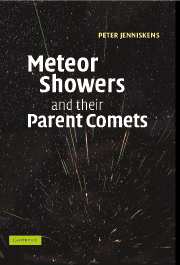Book contents
- Frontmatter
- Dedication
- Contents
- Preface
- Acknowledgements
- Part I Introduction
- Part II Parent bodies
- 6 Long-period comets
- 7 Halley-type comets
- 8 Jupiter-family comets
- 9 Fading comets of the inner Solar System
- 10 Asteroids as parent bodies of meteoroid streams
- Part III Young streams from water vapor drag
- Part IV Young streams from comet fragmentation
- Part V Old streams and sporadic meteoroids
- Part VI Impact and relevance of meteor showers
- Appendix
- Tables
- Index
- Units and constants
10 - Asteroids as parent bodies of meteoroid streams
from Part II - Parent bodies
Published online by Cambridge University Press: 05 July 2015
- Frontmatter
- Dedication
- Contents
- Preface
- Acknowledgements
- Part I Introduction
- Part II Parent bodies
- 6 Long-period comets
- 7 Halley-type comets
- 8 Jupiter-family comets
- 9 Fading comets of the inner Solar System
- 10 Asteroids as parent bodies of meteoroid streams
- Part III Young streams from water vapor drag
- Part IV Young streams from comet fragmentation
- Part V Old streams and sporadic meteoroids
- Part VI Impact and relevance of meteor showers
- Appendix
- Tables
- Index
- Units and constants
Summary
All the minor bodies of the solar system originating from beyond Jupiter's orbit are comets, even though their identity may long be hidden. In order to receive a comet designation, it is required that a cloud of dust or gas is detected. That means detecting a fuzziness in the image or other proof that a stream of cometary meteoroids is caused by the minor body.
Asteroids are the source of meteorites. Like comets, they are a remnant of the formation of the solar system, but they formed (and most spend all their life) closer to the Sun where ices did not remain frozen on dust grains and matter was compacted into rock. The name asteroid means “star-like” (Fig. 10.1). They are rocks larger than 1 m in diameter, somewhat arbitrarily discriminated from meteoroids because they are observed by telescope. The size limit has shrunk in recent years from ∼50 to ∼5m and is expected to go further down with the increase of sophistication in asteroid detection.
Asteroids have also long been championed as a source of meteoroid streams. Not the asteroids that make up the main belt between the orbit of Mars and Jupiter (Fig. 10.2), but the small fraction of asteroids that cross the orbit of Mars. Those that do not cross Earth's orbit are said to be of Amor-type, after namesake 1221 Amor (Fig. 10.3). Those that do cross Earth's orbit, but have an aphelion outside of Mars' orbit are called Apollo-type, after 1862 Apollo. Finally, those that cross Earth's orbit and have their aphelion inside the orbit of Mars are called Aten-type, after 2062 Aten. Near-Earth asteroids (NEA, q < 1.2 AU) return frequently to Earth and are about 80% of impacting bodies on Earth with diameter D > 1 km.
Most of these NEAs originate from the asteroid belt as a result of collisions between asteroids. Collisions can change the orbital period of a fragment into one that resonates with Jupiter. The result is a rapid increase of eccentricity and a decrease of perihelion distance until a close encounter with one of the terrestrial planets changes the orbital period again and puts it temporarily out of Jupiter's grip.
- Type
- Chapter
- Information
- Meteor Showers and their Parent Comets , pp. 140 - 150Publisher: Cambridge University PressPrint publication year: 2006



